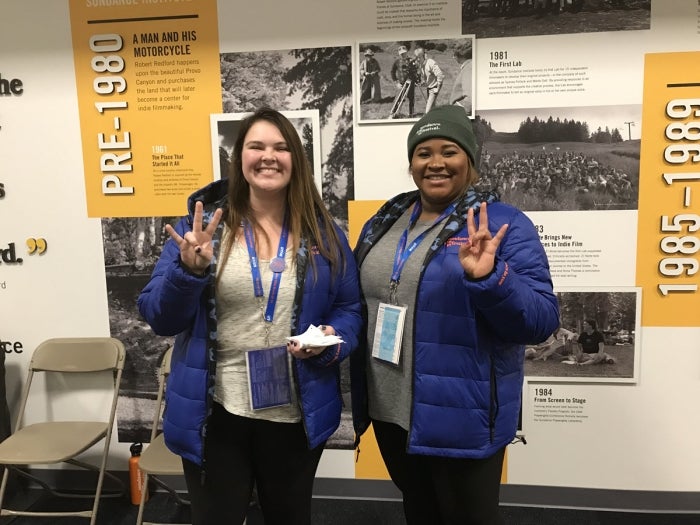What’s new at ASU English this fall

Then-doctoral student Emily Zarka combs through books from Hayden Library's stacks looking for traces of the books' past "lives" in this 2017 photo from an ASU Book Traces event. Photo by Andy DeLisle/ASU
Besides the usual cornucopia of courses, the Department of English at Arizona State University will launch undergraduate and graduate curricular changes and welcome several superstar faculty in fall 2021. The streamlined programs and the new faculty will foster student access and inclusion as well as diversify existing programmatic and faculty strengths.
More agile and straightforward
First up: the online Bachelor of Arts in English. The degree has been retooled so students can make more efficient progress toward completion. The restructuring includes a slimmed-down credit requirement (from 45 to 36) and what English’s Associate Director of Academic Services Linda Sullivan calls “a robust core of classes that runs the gamut from literature to rhetoric and from writing to research.”
Examples of the six new core courses include: ENG 211, an introduction to English studies broadly; ENG 308, a survey that explores how history and culture are reflected in literature and how in turn literature influences history and culture; and ENG 327, an introduction to research under the English studies umbrella. In addition to the core courses, students under the new curriculum will choose two elective courses in literature, writing, rhetorics and literacies, or film and media studies.
Associate Professor of English Bradley Ryner, who as associate chair for curriculum helped draft the revisions, explained that the curriculum "is designed to help 21st-century students to develop important skills for the study of literature, language and rhetoric while exploring a wide range of texts."
The updated online BA is more structured, but according to Sullivan, “still offers enough flexibility for students to tailor it according to their own interests and goals.”
Keeping up with the times
Next, the Bachelor of Arts in film and media studies — both online and immersion — has an updated core course that reflects contemporary media trends. Designed by film and media studies faculty Sarah Florini, Lisa Han and Jeffrey Holmes, FMS 351: Emerging Digital Media guides students through the ever-changing landscape of entertainment and social technologies.
Like the BA in English, the BA in film and media studies has also been trimmed from 45 to 36 credits, making for a smoother progression through the degree while opening up curricular possibilities. “Since the major no longer requires emphasis areas, students can choose from a wide variety of FMS courses to construct their own directed area of study," said Sullivan. Think customizable.
The updated course and curricular flow are efforts at keeping pace with trends in media industries during what Julia Himberg, associate professor and director of film and media studies at ASU, called “a time of pivotal change.”
“The digital world is constantly evolving, and FMS’s updated curriculum provides students the opportunity to learn about the most recent industry trends,” she said.
Film and media studies majors interested in hands-on coursework can choose an upper-division elective from The Sidney Poitier New American Film School to round out their academic training. As always, English’s internship program and The College of Liberal Arts and Sciences Futures Center remain rich resources for students interested in professional development and industry experience. Both in-person and remote internships are available.
It’s the past and the future
The Tempe campus Bachelor of Arts in English (literature concentration) is a mainstay of humanities study at ASU. It has now been updated to reflect the dynamic nature of literary and cultural research and is loaded with ample opportunities for intersectional study.
Like its online and film counterparts, the literature concentration also has a reduced credit requirement (45 to 33) and a revamped course structure that reflects national trends; students now can choose topical areas on which to focus — like desert humanities, or race and gender studies, for example — as opposed to chronological ones.
“There’s less emphasis on traditional time periods and geographic areas and more on contemporary, thematic studies,” said Sullivan. “The changes will provide students with a more diverse offering of courses that reflect cutting-edge research and literary analysis.” Among these new courses is ENG 206, an introduction to literary research that’s taught by history-of-reading researcher Brandi Adams, a new addition to the ASU faculty. Additional new courses are under development.
“In addition to Brandi Adams’s class, the new structure is enabling us to introduce some really exciting topics,” said Professor Jonathan Hope, who directs the department’s literature program and has helped shepherd the curricular updates. “Assistant Professor Henry Quintero’s ENG 332: Entheogenic and Psychedelic Literature is something I’d definitely be signing up for if I could! In spring 2022, we’ll have classes from more of our new faculty, including Assistant Professor Ruben Espinosa (ENG 332: Studies in Race and Ethnicity) and Assistant Professor Lisa Barksdale-Shaw (ENG 321: Shakespeare). Clinical Assistant Professor Madeline Sayet will teach Native American drama in 2022–2023.”
For all of these undergraduate programmatic changes, continuing students have the option to switch to the new catalog year if they choose. Confused? Reach out to English’s award-winning undergraduate advising team for support and suggestions: englishadvising@asu.edu.
Sustainable coursework
The Department of English’s undergraduate programs aren’t the only ones getting upgrades; the online Master of Arts in English also features a curricular boost.
To make available the deep expertise of English’s environmental humanities-focused faculty, the department has introduced a new elective in the program. ENG 598: Studies in Environmental Humanities is co-taught and co-developed by two field experts: Joni Adamson, President’s Professor and recent National Humanities Center Fellow who directs the Environmental Humanities Initiative of the Julie Ann Wrigley Global Futures Laboratory, and Lisa Han, assistant professor in film and media studies at ASU, who was awarded a 2021–2022 fellowship by the Institute for Humanities Research for her project exploring mediation of the seafloor.
Kathleen Hicks, director of English’s online programs, described the significance of adding interdisciplinary sustainability as a key part of the program.
“The course incorporates important frameworks from the sciences, philosophy, literature and film to help students think and write about critical environmental issues,” she said. “They will now have the opportunity to study environmental humanities at ASU with top scholars in the field.”
Hicks also nodded to the MA program’s popularity with working K–12 educators: “I am hopeful our teacher-scholars will be inspired to pass their learning onto their students, thereby greatly magnifying the course’s impact.”
If you build it, they will come
Finally, the university’s investment in a cohort of humanities scholars, teachers and artists of color brings specialists in medieval and early modern studies, performance, poetry and fiction/nonfiction writing to ASU this fall. The new faculty join luminaries already in residence, like Associate Professor Natalie Diaz, winner of the 2021 Pulitzer Prize in Poetry, who holds the Maxine and Jonathan Marshall Chair in Modern and Contemporary Poetry and who directs the Center for Imagination in the Borderlands; and Regents Professor Ayanna Thompson, a Shakespeare scholar recently elected to the American Academy of Arts and Sciences and also named a trustee of the Royal Shakespeare Company, who directs the Arizona Center for Medieval and Renaissance Studies.
“In the Department of English at ASU, we try to put students at the center of all our decision-making,” said Professor and Chair of English Krista Ratcliffe. “In that spirit, we hope the program updates and the new faculty and staff joining us this fall make it an exciting time to be an undergraduate or graduate student in our department.”
More Science and technology

ASU water polo player defends the goal — and our data
Marie Rudasics is the last line of defense.Six players advance across the pool with a single objective in mind: making sure that yellow hydrogrip ball finds its way into the net. Rudasics, goalkeeper…

Diagnosing data corruption
You are in your doctor’s office for your annual physical and you notice the change. This year, your doctor no longer has your health history in five-inch stack of paperwork fastened together with…
Large-scale study reveals true impact of ASU VR lab on science education
Students at Arizona State University love the Dreamscape Learn virtual reality biology experiences, and the intense engagement it creates is leading to higher grades and more persistence for biology…





